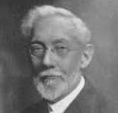Clarence Larkin
Clarence Larkin (1850–1924) is important as the source of many of William Branham's basic premillennial dispensationalist teachings in addition to a few other of his unique doctrines. William Branham mentioned Larkin on three separate occasions but never gave him credit even though he often quoted Larkin verbatim.


Did William Branham ever give credit to Larkin?
William Branham first mentioned Larkin over 7 months after preaching the seven church age series which was almost totally plagiarized from Larkin. The second time was a few days later. And the third mention of Larkin was well over one year after preaching the seven seals series which again were consistently plagiarized from Larkin (and Charles Taze Russell). In each case, he states that he does not agree with Larkin. Here are the ONLY three references to Larkin that William Branham makes in all of his sermons:
- I've been reading Dr. Larkin's book, Dr. Smith's book, Dr. Scofield's notes, different commentaries from men everywhere, and yet I cannot put theirs together to make it come out right. (July 30, 1961, Sermon: Gabriel's Instructions to Daniel)
- And so, no doubt that down through the age, there has been hundreds times hundreds of people, scholars, abled men, trying to explain what these seventy of weeks were. And I’ve read many of their commentaries on it. And I’m very grateful to Mr. Smith, of the Adventist church, for his views. I’m very grateful to Dr. Larkin, of his views. I’m grateful to all these great scholars, for their views on this. And in reading them, it enlightens me much, that I can find places that looks right. But to get the views that I—I thought that I would like to explain, I searched through the encyclopedia, of “time,” to find out what “time” meant. (61-0806 - The Seventieth Week Of Daniel, para. 51)
- And I had read Mr. Larkin. I had read, oh, so many different ones, of their commentaries on This. But, somehow or other'n, I thought I had a--a little view of it, myself, that might be of places different. ...But then just before it happened, I was given a vision, which is on tape, as you all know, Sirs, What Time Is It? that I should go to Tucson, Arizona. ...There where the Angel of the Lord met us, and the Bible become a new Bible. There It opened up and revealed all the things that the reformers and things had left out. It was the complete revelation of Jesus Christ, altogether new to us, but perfectly exactly with the Scripture. That was the Word which has always been. I was so inspired and directed. (July 19, 1964, The Feast of the Trumpets)
In these above quotes, William Branham says that he doesn't agree with Clarence Larkin or other commentaries. This gives the impression that the doctrine he preached was his own original ideas or lessons he received directly from the Angel (and not from anywhere else).
Who was Clarence Larkin?
Larkin was educated as an engineer. He joined the Episcopal Church, but was afterward ordained as a Baptist minister. When the first World War broke out in 1914, he was called upon to speak on “War and Prophecy,” which led him to the preparation of numerous charts and outlines, which finally appeared in the form of a large volume entitled Dispensational Truth, or God’s Plan and Purpose in the Ages, which is the great work on the subject. It was first issued in 1918. A revision appeared later, and the book has gone into fourteen printings. It would be impossible to go into detail as to this book without occupying more space than can be given here. He identifies the days of the creative week with the seven thousand years of human history, and adds an eighth, the duration of which is unknown, extending from the destruction of Satan to the surrender of the kingdom. His dispensational outline is as follows:
- I—Antediluvian age:
- 1—Edenic dispensation
- 2—Antediluvian dispensation
- II—The Present age:
- 3—Postdiluvian dispensation
- 4—Patriarchal dispensation
- 5—Legal dispensation
- 6—Ecclesiastical dispensation
- III—Age of Ages:
- 7—Messianic dispensation
Larkin has 176 large pages of explanatory material and charts covering every conceivable subdivision of the subject, and one would have to go through this material to understand what labor the author put on it during the three years he spent on developing it. He also has a book entitled Rightly Dividing the Word, containing the cream of his sermons and Bible lectures over a period of 30 years.[1]
Larkin's works are available in a low cost electronic format at The Bible Analyzer website.
Footnotes
- ↑ Arnold D. Ehlert, “A Bibliography of Dispensationalism,” Bibliotheca Sacra 102 (1945): 462–463.